News from a Changing Planet -- #24
Given that the last three years have turned us into a nation of backseat epidemiologists, maybe it follows that we have a better understanding of the importance of basic science research, or research that doesn’t immediately yield practical applications. Who knows – today’s cell culture of lipid nanoparticles could be a millions-of-lives-saving vaccine in 20 years!
This delayed gratification is easier to understand or to calculate in the case of medical research than behavioral ecology, maybe, but today I’d like to make a case for the crucial importance of the latter, especially in the case of human health – specifically, how learning about fish sociality might help prevent a global malnutrition crisis.
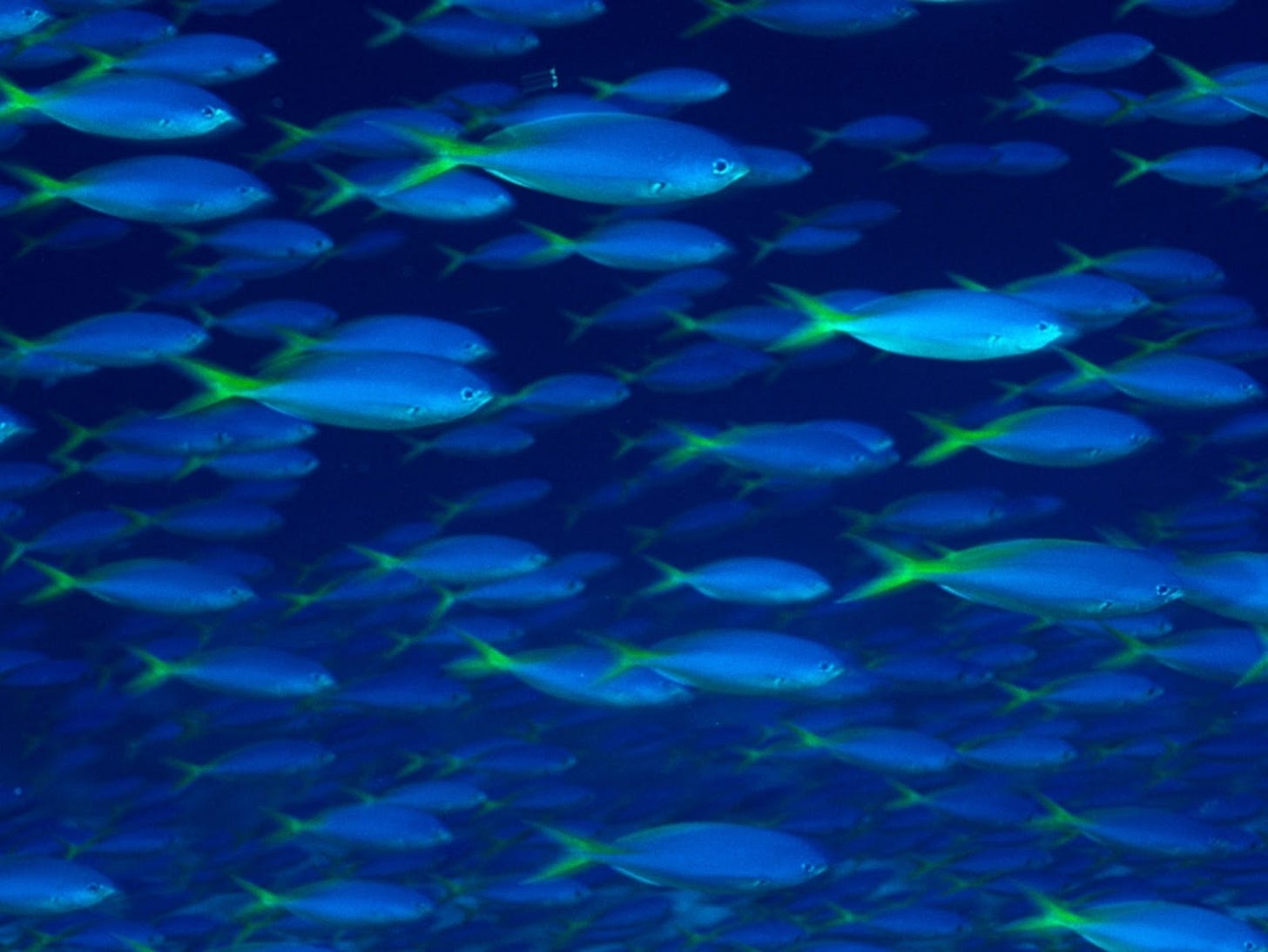
Yellowtail fusiliers swimming in a school in the Marshall Islands. Credit: National Geographic
Broadly speaking, ecology is the study of how organisms interact with their environment. These days, even when scientists aren’t looking at the influence of human behavior on that of other organisms, they actually are – the fingerprints of human behavior are everywhere, even if indirectly, from carbon pollution in the atmosphere to microplastic at the bottom of the ocean.
When we talk about the present and future impacts of climate change, coral reefs are among the habitats we talk about the most, along with polar ice caps or melting glaciers. We usually talk about bleaching, which happens when corals are exposed to warm ocean temperatures. In a symbiotic relationship, coral animals (and they are animals, which is always worth remembering) host algae (zooxanthellae) which give a coral its color. When the corals get stressed, they spit out the zooxanthellae and lose their color, which is what turns them white. Often, they can recover, and the algae can come back, but if they experience these kinds of conditions repeatedly, they may die.

A healthy table coral and a dead table coral. The zooxanthellae algae give the reef its color on the left. In the photo on the right, the coral animals have died, and the algae are gone. Credit: Wikimedia Commons; Greg Torda, ARC Centre of Excellence for Coral Reef Studies
The balance between corals and zooxanthellae is one of the things that makes coral reefs such hotspots of biodiversity – they can support all different kinds of life. But there are lots of other organisms competing for resources, too. In coral reef ecosystems, the coral reef structures are always competing with macroalgae (or seaweed), which are also using the sunlight the zooxanthellae rely on for energy. In a healthy reef system, there’s a balance between the corals and the macroalgae that allows them to support lots of different species – herbivores and the fish that eat them and the bigger fish and sharks that eat those. But when one form is dominant – either the coral or the macroalgae – the reef ecosystem can fall out of that equilibrium. For example, excess nitrogen (from fertilizer runoff or human wastewater) in a reef system can cause algal blooms (nitrogen=nutrient) that take over a reef, making it hard for the corals to grow and survive.
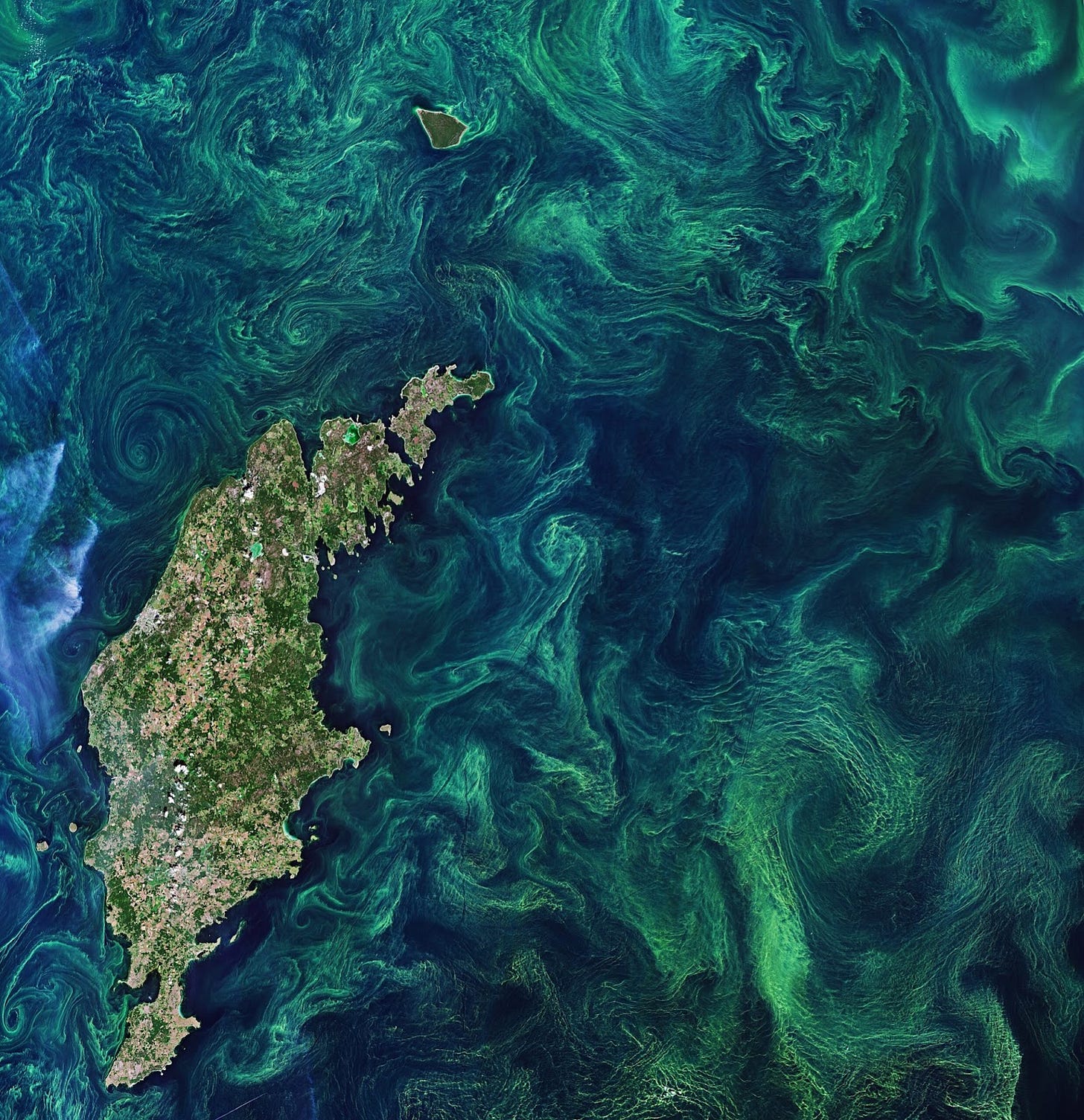
This is an algal bloom from nutrient pollution in the Baltic Sea. Credit: Copernicus Programme.
Herbivores, like certain kinds of fish or sea urchins, eat algae – in some cases, they even farm it – preventing the reef from becoming either algal-dominant or coral-dominant. (Can you believe how cool that is - fish can farm!) A 2018 study on fish behavior in French Polynesia found that unschooled fish (read a book cmon) were more likely to graze in unprotected areas (more exposed to predators) if there were other fish already eating there, and they would stay longer and eat more algae with other fish around than they would if they were alone.
The effects of climate change – bleaching, as well as ocean acidification and sea level rise, which also threatens reefs – also make it harder for these fish to survive. That, In turn, makes it harder for the reefs to survive: if the fish aren’t there to eat the algae, it’s more likely that the algae could take over the reef.
And then we get to overfishing, which plays into the same cycle, but there’s more…which brings us back to the work of our good friend Doug McCauley! In addition to saving the whales and the sharks, collecting plastic from the rivers, organizing against deep sea mining, he also studies fish sociality in French Polynesia.
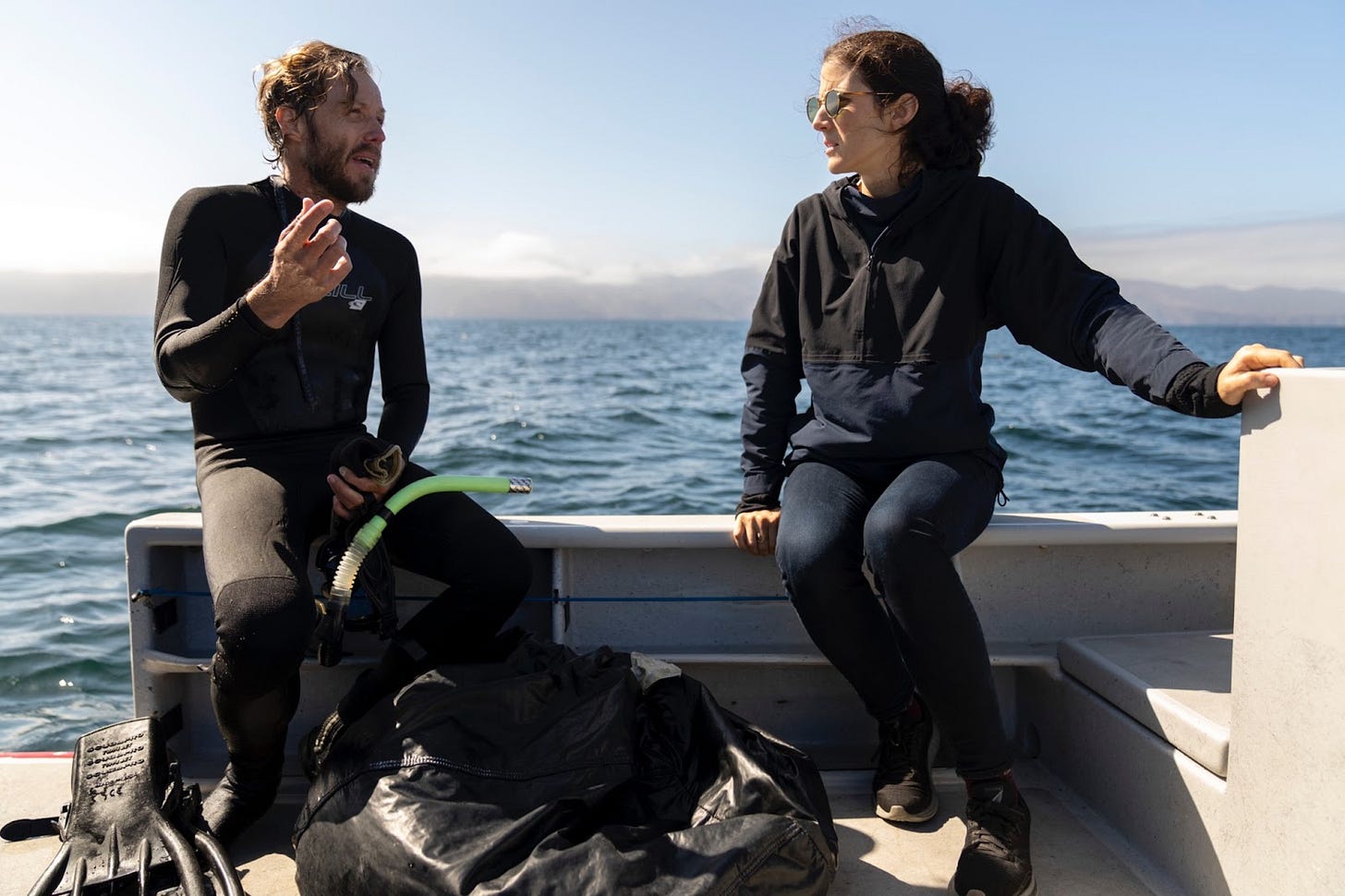
Here we are, chatting fish behavior, maybe. Credit: Lauren Justice
On reefs generally and across the global oceans, people prefer to hunt large fish in schools. Fish, on the other hand, prefer not to be caught. As such, they may be adapting their behavior to ours, thereby avoiding swimming in schools so they don’t get caught, and becoming more anti-social. “Are we actually killing the schooling behavior or are we driving it locally or globally extinct?” is one of the questions that McCauley, Ana Guerra (one of his recent PhD graduates), and their fellow researchers are asking. In computer simulations of fish behavior, they saw that the ocean became full of anti-social fish after just a few generations of industrial fishing.
But it’s less about the numbers of fish in the school, and more about how they behave. When they’re all together, they take on a different ecological role in the reef, acting sort of like a megafish, becoming super-herbivores.
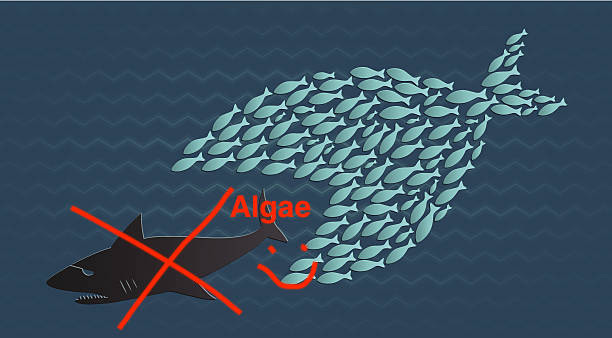
Like this, but real. Credit: drante via istockphoto; edits by me ;)
In fact, certain kinds of fish – the surgeon fish that McCauley studies – raid the algae that other fish (damselfish) farm, which he thinks may play an important role in algal dominance on reefs.
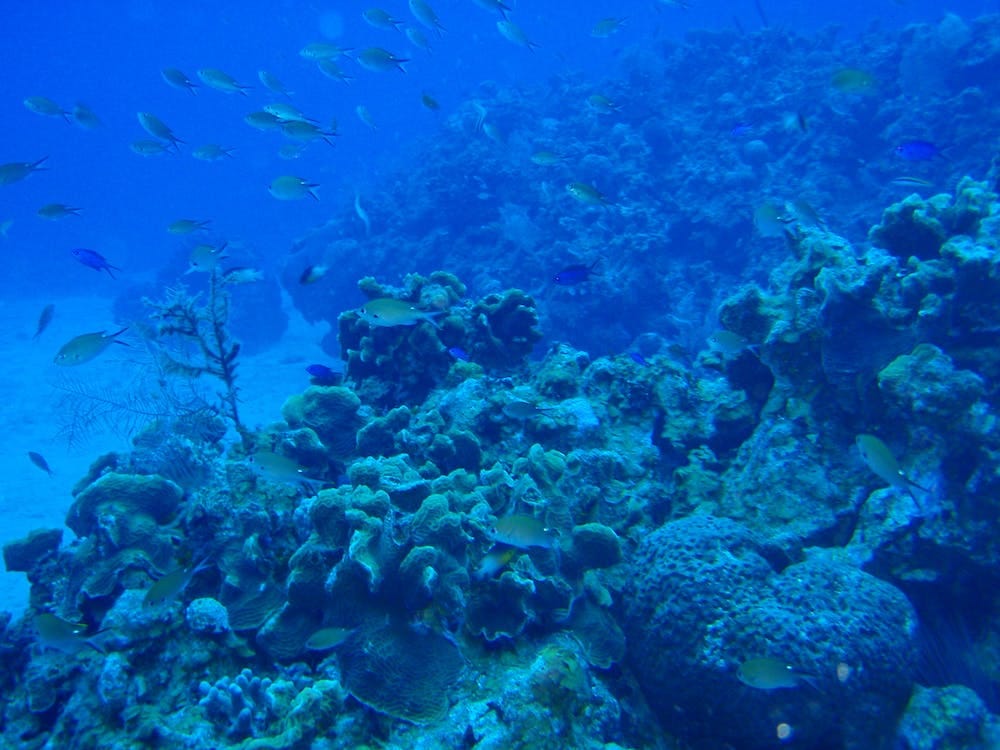
Longfin damselfish farming,managing and feeding algae on a reef off the coast of Belize. Credit: Andy Blackledge
So, if you take these fish out of the ecosystems or you cause them to change their behavior (becoming lone wolves rather than team players), it might further upset that balance between coral and algae, possibly further imperiling coral reefs, which are already wobbling on the edge of climate change tipping points.
The goal of the research, McCauley said, is “to describe the feeding ecology and behavioral ecology of these mega-herbivore fish schools to better understand, ‘How is human fishing shaping fish behavior, and is that actually an underappreciated part of how we maintain this balance on reefs?’”
The upshot of these various stressors is less fish on reefs, and less fish in general. Climate change may also change where and when they swim, possibly pushing them out of reach for many coastal populations that rely on them for nutrition. Fish are particularly important in delivering micronutrients, like iron, zinc, omega-3 fatty acids, and vitamins, so-called because we only need them in small amounts.
Deficiencies in micronutrients can increase the risks of maternal and child mortality, lead to cognitive impairments and reduced immune function, and slow children’s growth. Nearly half of child mortality is attributable to undernutrition.
In a paper from 2016, McCauley and several colleagues calculated that about 10 percent of the global population are vulnerable to deficiencies in either zinc, vitamin A, or iron, and a further 20 percent are at risk of deficiencies in vitamin B12 or DHA omega 3 fatty acids because of overfishing and declining fish populations around the world.
As is often (if not always) the case, the health consequences of overfishing and habitat degradation will be borne by poor countries. In low-latitude developing nations (the tropics), human nutrition is most dependent on wild fish. All but three of the countries that are most dependent on fish for nutrition are in the developing world, according to that paper. Countries with the highest levels of undernourishment are also typically net-exporters of much of their seafood to resource-rich countries.
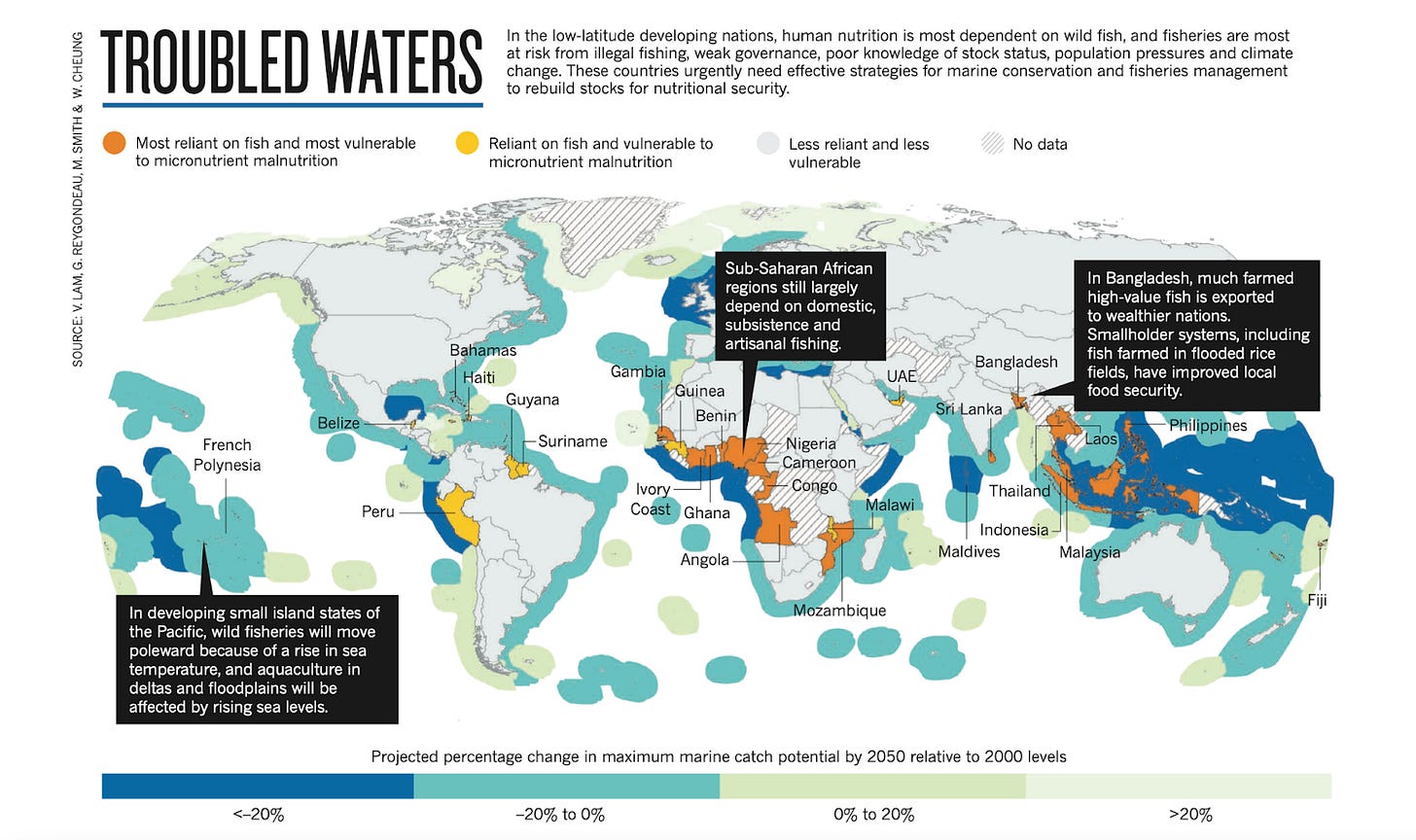
This map does a better job explaining what I am trying to articulate here! Credit: V. Lam, G. Reygondeau, M.Smith and W. Cheung
Ocean warming and shifts in primary production are already changing where fish and shellfish are – possibly reducing global catch rates by 6 percent overall, and by 30 percent in the tropics, by 2050. Fish will also likely get smaller, with biomass reductions of about 20 percent projected. Coral reefs and mangroves, nurseries for many fish species, are already at risk.
In lots of places in the Global South, “fish are like free-range kids’ vitamins,” McCauley told me. Catches may go up in places like Norway, as fish look for colder waters, but they will go down in places like Ghana or Kiribati, where fish and rice is what’s for dinner, except that maybe it’s just rice now. Or it will be soon.
McCauley and his colleagues have been studying the nutrition and health of communities in Kiribati, a low-lying remote republic in the South Pacific, made up of 33 islands, 20 of which are inhabited. In countries like Kiribati and others, the coral reefs are like a “big old nutritious refrigerator,” said McCauley, and if the ocean ecosystems are healthy, then the people are less likely to suffer from these diseases of malnutrition. But if coral reefs aren’t thriving and the fish aren’t around then what happens? Beyond reefs, bigger pelagic species like tuna are also being overfished, or shifting their ranges, making them more inaccessible to coastal communities. This has the compounding effect of making coral reef species even more crucial for nutrition, just as they are struggling to survive.
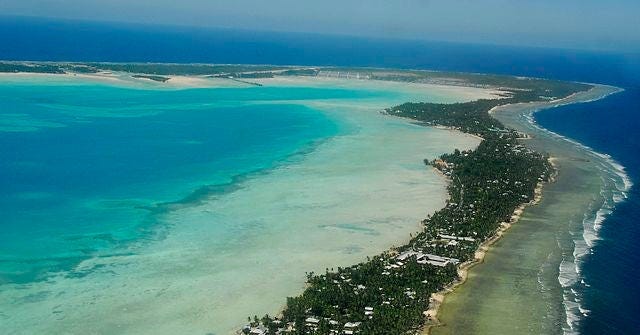
Tarawa, the capital of Kiribati, which is an atoll. Atolls are formed when coral reefs grow around an oceanic island, forming a fringing reef. Over the next several thousand years, the reef keeps growing as the interior island subsides, turning the fringing reef into a barrier reef. When the island completely sinks below the water, leaving a ring of reef around a central lagoon, it is called an atoll. Credit: Government of Kiribati
The decline of these wild food systems is taking place alongside the “nutrition transition,” a shift towards a Western diet of highly-processed, sweetened, calorie-rich foods. In a 2021 paper, McCauley and his colleagues argued that there are feedbacks between the socio-economic and natural dynamics that are accelerating this transition, possibly locking certain nutritional outcomes in place.
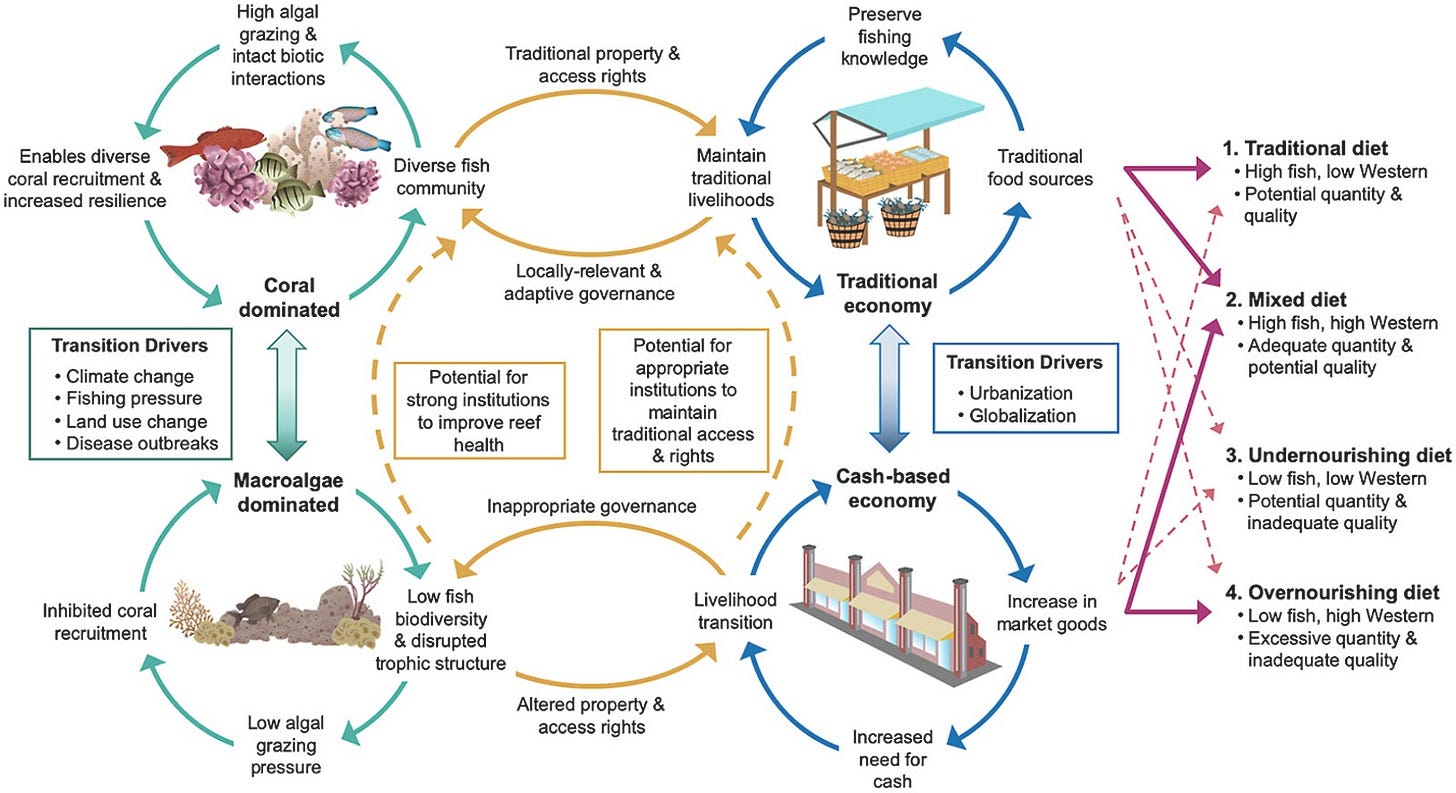
Here is a figure from the study illustrating some of the possible feedback scenarios. Credit: C.D. Golden et al., Global Food Security, Volume 30, September 2021, 100561
(There are emissions and energy implications for the nutrition transition as well, which I’ve written about previously. The dietary shift that has received the most attention, probably, is that the growth in the urban population and the size of the global middle class in the developing world would also mean more meat consumption, similar to Western diets. This has happened, but there are other changes that are worth paying attention to. Karen Seto, a professor at the Yale School of the Environment, has found that there are lots of other changes taking place alongside more meat consumption: more demand for prepared food, restaurant food, and refrigerated food. Such a shift requires different storage, refrigeration and transportation, a thorny challenge as much of the energy in these economies remains fossil-fuel dependent.)
It can be hard to see the links between fish sociality and the health and wellbeing of the millions of people who live in Pacific Island nations, or other coastal communities that depend on wild fisheries (not to mention that many of these nations sell fishing rights in their national waters to other countries, which also means that these markets don’t “leak” into their communities either). But just because we don’t see them or think about them doesn’t mean they aren’t there. On the one hand, we shouldn’t need a study of fish sociality to tell us that people who rely on coral reef ecosystems have a right to a healthy ocean -- we should already be working to make that happen. On the other hand, we need the science to tell us just how these patterns are taking hold in a changing ocean so that we can plan for the future, and make sure that our plans take into account the basic needs of the people who are most vulnerable to chaos and least responsible for it.
I think research like this, which brings together human influence and animal behavior, also shows us just how closely connected we all are to these problems, that we all live on one planet with one atmosphere and one ocean. I may never see a surgeon fish on a reef in French Polynesia, but I buy produce that was grown in Mexico that is probably responsible for agricultural runoff, nutrient pollution, and maybe even algal dominance on a coral reef, making it harder for some people there to get the nutrition they need.
That is not to say that I am directly responsible for that malnutrition or that it’s possible to consume with no impact at all. The point is that we are all in this together – that none of us are isolated from the causes and effects of climate change. And it’s research like this that can bring it to life.
Thank you for reading and please write to me with any questions or comments. I love to hear from you, even if I don’t always write back -- I try my best!
Tatiana

